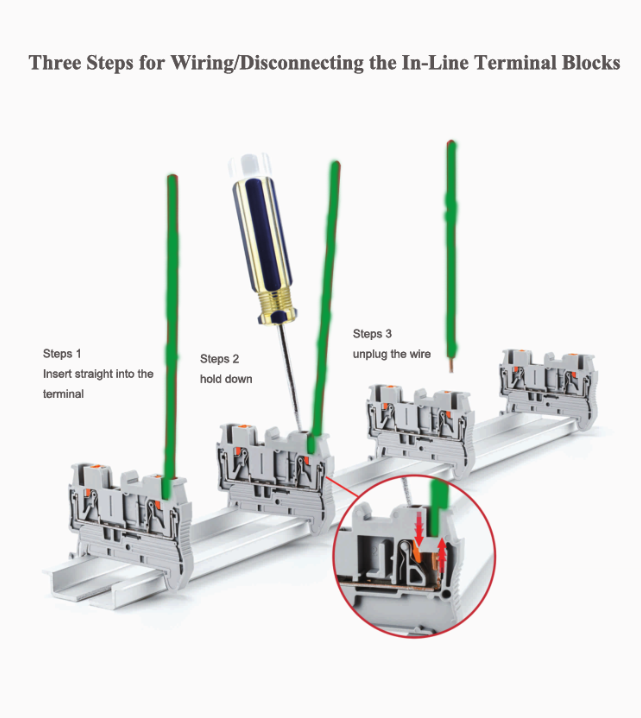SMICO Push In Din Rail Mounted Terminal Blocks
1. DESCRIPTION:
The Push-in connection terminal blocks reduce the wiring time , and can support simply wiring in places where is only a little space available. You don't need any tool, just insert the cable is ok.
◆ Made from anti Inflaming Nylon PA 66, copper metal.
◆ Connecting, build bridges and labeling large or small conductor cross sections easily for feed through terminal blocks.
◆ Wiring can be handled in a limited space thanks to the compact design and front entry connection.
◆ With universal foot which can be installed on 35mm Standard Din Rail.
◆ Build electric potential distribution by using plug-in bridges in the terminal center.
◆ Available in all accessories: End covers, End Stoppers,Marker strips, Marker carrier, Plug-in bridge, etc.
Basic Information
SMICO ID | PT16-3-G |
| Pitch | 12.2mm |
| Number of levels | 1 |
| Number of connections | 3P |
| Connection method | Push in spring terminal |
| Protection Level | IP20 |
| Work temperature | -40~+105℃ |
IEC Data
| Rated Current | 76A |
| Rated Voltage | 1000V |
| Overvoltage category | Ⅲ |
| Pollution degree | 3 |
| Rated impulse voltage | 8KV |
| Conductor cross section solid | 0.5-25mm² |
| Conductor cross section flexible | 0.5-16mm² |
| Conductor cross section flexible,with furrule | 0.5-16mm² |
| Stripping length | 18mm |
UL Data
| Use group | B | C | D |
| Rated Current | 85A | 85A | - |
| Rated Voltage | 600V | 600V | - |
| Rated cross section | 20-4AWG | - | - |
Material Date
| Insulation material | PA66 |
| Insulation material group | Ⅲa |
| Flame retardant grade, UL94 compliance | V0 |
| Contact material | Copper alloy |
| Surface characteristics | Sn,Plated |

Set 1: Prepare the wires to be connected
Set 2: Directly insert the cable, no tools required
Set 3: Screwdriver into the orange button
Set 4: Unplug the wire, the wire withdrawal is complete

1: High-strength spring
2: Copper conductive strip
3: Imported flame-retardant nylon PA66
Comparison of spring clamping and screw clamping
The SMICO terminal has confirmed to many customers the actual use of the terminal. Taking manual wiring as an example, the spring-clamped terminal is more than 45% less used than the screw-type terminal. Even when compared with an electric screwdriver, the spring clamping still has the advantage of saving time. (In many applications, wire preparation, such as crimping wire ends, cold splices, or tinning, saves even more time.) The screw-clamping link is "completely operator-dependent", i.e. the screw-clamped The degree of tightness requires the operator's judgment. This may be more or less controlled with the operator's specific torque screwdriver's factory setting. When wiring in the field, it is more difficult to ensure the proper degree of screw clamping. The spring auto-clamping feature allows less skilled operators to complete joints with high quality. Accurate and consistent contact connections can be completed no matter who is operating. The tool used is just a standard screwdriver.
About SMICO Spring Terminal Blocks
1. SMICO spring terminal block has front wiring, side wiring and 45° wiring form
2. The wiring steps of the spring terminal: insert the tool - insert the wire with the stripped insulation layer - pull out the tool, the wire is automatically clamped.
3. The SMICO spring terminal can automatically adjust the clamping force according to the wire diameter of the wire, and the same quality can be achieved regardless of whether the operator is skilled or not.
4. The contacts of the SMICO spring terminal block can be airtight, the contact resistance is small, anti-corrosion, vibration resistance, stamping resistance, shorten the maintenance time and prolong the maintenance period.
Spring terminals do not require frequent inspection or retightening of terminals that have become loose due to disturbances, temperature cycling, or broken strands. The inherent reliability of spring terminals reduces downtime and user repairs. According to statistics, 35-50% of equipment maintenance is due to bad contacts. Considering the high cost of maintenance and lost production time, this savings is significant.
For the purpose of safety, reliability and ease of troubleshooting, many industry and national standards specify "one wire per tightening point".
SMICO spring terminal blocks can provide users with terminals for two-wire, three-wire, and four-wire contacts. The same jumper bridge applied to the upper insulation can easily connect adjacent or spaced terminals together. In both cases, each wire has its own contact clamp, and due to the front wiring feature, it does not require the larger space of a two-wire terminal.
The spring clamp has been designed to give proportional tightening force according to the wire size. The thicker the wire diameter, the greater the clamping force. The flat surface area of the spring in combination with the deflector bar with a special curved surface provides a secure connection that does not damage the wire. At the same time, the special design of the spring angle, when the pulling force is applied, also increases the clamping force.
SMICO spring terminal blocks and connectors have a complete wire entry, which can be tightly clamped to the wire. The shell design of the product, combined with the unique properties of the spring, can ensure that the wire is automatically positioned in the contact area, which can effectively prevent the stranded wire from unraveling.



















